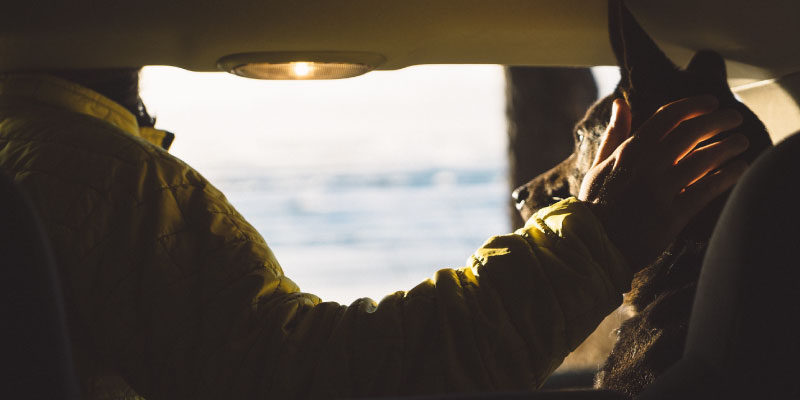If you are wondering what the best way to travel with your dog in your car might be, we take a look at all the options available and any legal restrictions you need to know.
We’ve all seen the clips of dogs sticking their heads out of car windows, having the time of their lives as the wind rushes through their fur. A happy dog is a safe one, right? Well, not always.

Many factors will affect how your dog responds to travelling with you in a car. You may have just bought/adopted the dog, it may be a puppy, or it may be a large breed that struggles in smaller cars. You’ll have to consider all of these before you venture out with your pup, especially on long journeys.
If you’re planning a long trip, read our guide on the safest way for dogs to ride in cars.
Is it illegal to have an unrestrained dog in a car?
This all depends on your country of residence.
In most countries there are no specific laws governing how dogs should travel in cars. However, each country will have different advice: in the UK the Highway Code states that the dog should be “suitably restrained”. This if, of course, open to interpretation depending on how open your car is and how large your dog.
The UK Highway Code goes on to say:
“When in a vehicle, make sure dogs or other animals are suitably restrained so they cannot distract you while you are driving or injure you, or themselves, if you stop quickly. A seat belt harness, pet carrier, dog cage or dog guard are ways of restraining animals in cars.”
So, as far as the law is concerned, you cannot technically be penalised for not strapping your dog in. However, you can be prosecuted for driving without proper control of your vehicle. The police are well within their rights to stop you if they think you don’t have adequate control of your dog/car. This could result in a fine of up to £5,000, and nine points on your licence.
This is generally how most countries and states will deal with dogs in cars: as long as they are no hindering your driving, no one will bother you.
Where it gets complicated in countries like Australia and the United States
It’s easier when talking about dog laws in countries like the United Kingdom and New Zealand which are relatively small and easy to pass laws to apply to all.
When you get to the US, or even Australia, things can vary widely from state to state. So we would always recommend you take local governmental advice on what you should do.
Currently, at the time of writing, not many states had express laws regarding restraining your dog in the car. Exceptions include Connecticut, Rhode Island, Maine Massachusetts, Minnesota, and New Hampshire who all have specific laws passed on how to restrain your dog safely.
In Australia, laws also vary from state to state, but (wonderfully) the focus here is on the safety of the animal. So whilst it is not illegal to drive with a pet in Australia, you must do so in a way that doesn’t threaten the safety of your animal.
One law that is universal across the whole of Australia is that you cannot drive with your dog in your lap. Fines vary, but they tend to be in excess of $200 and a few demerits. More importantly, the RSPCA can also issue fines and jail time if you endanger an animal.
In short, regardless of where you live, if you stick to the safe ways to travel with your dog in a car below, you’ll hopefully be covered.
What is the safest way for dogs to travel in a car?
When travelling with your pup, you’ll want to consider the safety and comfort of yourself, your dog and your passengers. Luckily, there are a number of dog care safety products on the market.
The options below can generally be used either in the back seat of the car or in the boot. As a general rule, we cannot recommend that you allow your dog to sit in the front, and almost certainly not in your lap.
Dog seat belt leash
If yours isn’t too excitable a dog, a simple belt extension/belt leash may be enough. These attach to your pet’s collar and allow them to sit, lie down or even stand comfortably in the car. Keep in mind that they will have to sit with other passengers, so it’s best to avoid these if you have young children or your dog is nervous around people.
For younger dogs, a puppy seat belt may work better. Similar to a harness, this can be affixed to the middle seat and lets younger dogs sit happily with freedom to move their legs. Make sure it’s tight and secure, allowing for enough movement to sit or lay down, but not enough to roam.
These are the bare minimum in dog safety.
Dog car harness
These are slightly upgraded versions of puppy seat belts. Again, they can be attached to the middle seat, and may even position your dog slightly off the seat itself, so its paws are dangling.
If you’re worried this might be uncomfortable, you can also get dog harnesses with attachable seats, similar to a baby car seat.
A car harness can also be used in the boot of a car, as long as there’s a way to secure them. Car harness are generally considered the best as if there is a crash, they won’t be pulled at the neck, potentially doing a whole load of harm.
Dog seat hammock
These are the lap of luxury for bigger dogs! Strap a hammock across the back seat and watch your dog relax into its own comfortable space. Of course, this means there’s no room for passengers on the back seat, but it does free up your boot for luggage.
Dog car crate
For larger breeds, you may want to consider a dog car crate. These sit in the boot of your car, so they’re ideal for SUVs or other larger cars. The safest dog crates for cars are lightweight and crash tested. You can make your dog feel more comfortable by adding blankets, treats, and their favourite toys.
Even for puppies, if you are looking at getting them used to the boot of the car, putting their crate in there to begin with is a good way to get them used to travelling. Once they seem comfortable, you can remove the crate and keep them in the boot.
How do I secure my dog in the boot of my car?
If you have a smaller boot and/or a smaller dog, you may not have to use a crate. However, it is the easiest way to get them contained and used to this new and (at times) frightening environment. You can add blankets and might take some coaxing to get your dog into the car.
The boot is the easiest and safest way to travel with your dog, but we know this isn’t always possible. When travelling on long journeys, for example, you may need the boot space in order to put luggage.
For less mobile (ie. older) pups, ramps are also a good option. Try to make the boot as accommodating as possible by removing excess luggage and adding blankets.
Always remove the parcel shelf, but ensure your dog cannot make its way into the back seat. If that means tying them with a harness, or putting a mesh dog guard between you dog and the backseat, so be it.
If you train your dog to ‘wait’ and not jump out of the car until you tell them to, you may not need to use a harness or leash, but always err on the side of caution.
The safest way to travel with dogs in cars – some don’ts
You can keep dogs safe in cars by complying with the Highway Code and responding to their needs. However, there are certain things you should avoid when travelling with your pooch.
Don’t let your dog hang its head out of the car while moving.
It’s fine for your pup to stick its head out of the window while you’re loading up, but these should be closed when the car is in motion. You run the risk of your dog’s head colliding with other vehicles, so while it might look fun, it’s highly dangerous.
Don’t use airbags if your dog is in the passenger seat.
These are likely to cause more harm than good to dogs sitting on the back seat, so make sure you disarm them if you can.
Don’t give your dog a meal right before you drive.
We’re all prone to car sickness, but feeding a dog before you move might upset its tummy, disrupting your journey further. Some dogs are more prone to this than others, of course, but if it’s the first time doing a long journey… better safe than sorry.
Don’t leave your dog in a hot car.
This is by far the most important pointer for anybody driving with a dog. For starters, passers-by may feel inclined to smash the window on the grounds of the dog’s safety. Even if it’s just for a few minutes, a car can heat up to 42°C, causing heatstroke and even death. Don’t run the risk.
Other tips to keep dogs safe in cars
You want both your passengers and your dog to enjoy journeys wherever you go. Before you set off, remember to:
- Make sure your dog is microchipped in case it goes missing
- Keep windows only slightly ajar to stop dogs jumping out
- Keep water bottles topped up as often as possible
- Make regular stops for comfort breaks
- Consider fitting sunshades to protect your dog from sun glare
- Try to encourage your dog to relax. Play with them and show them affection before you get into the car. You could even try giving them their favourite toy to put their mind at ease
- Discourage young children from touching/harassing the dog too much
- Keep loud music to a minimum to make your dog feel safe
- Add blankets or cushions to encourage your dog to rest
- Go to fun places – you don’t want your dog to associate car trips with going to the vet and nothing else. Take your dog on adventures – new spots for walkies, kennels – whatever makes them happy and sociable!
As a driver, it is your responsibility to look after yourself and all your passengers, including the four-legged ones. Only set off once you’re happy that everybody is belted up or otherwise restrained. Try to keep distractions to a minimum like music and mobile phones (which should be handsfree only).
The best way to socialise your dog is to encourage it to visit new places. A day trip to the beach or a national park is a great way to start. Once your dog realised that car trips end in wonderful adventures, they will be happy to jump in the car and join you in the endless possibilities.
Related: If you’re thinking of taking your dog to the beach, take a look at our dog beach packing list.




